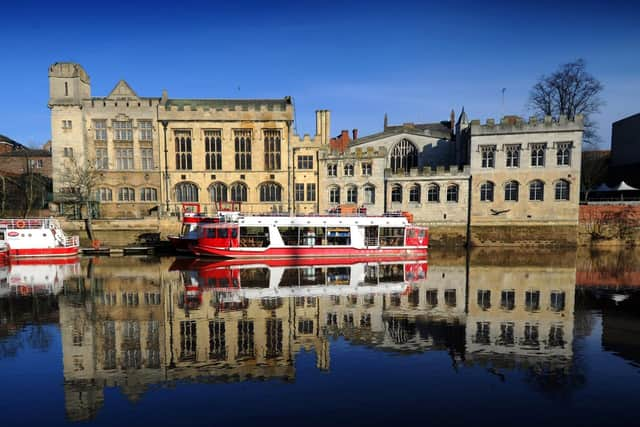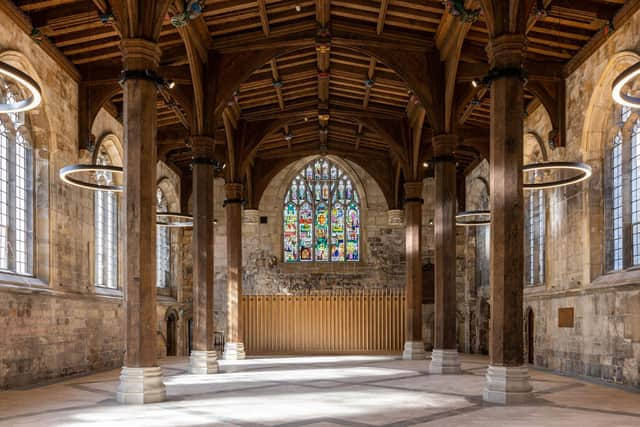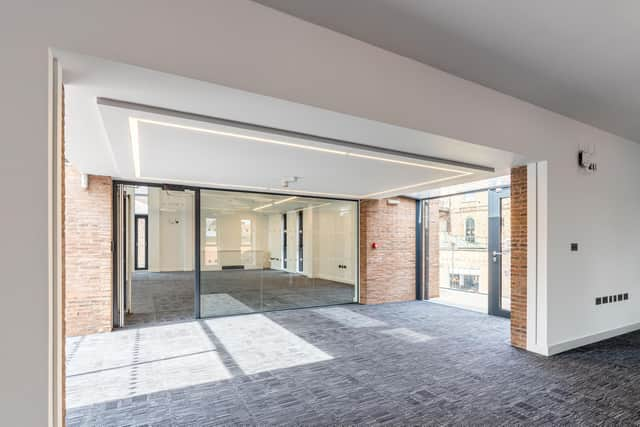Inside York Guildhall's restoration: New roles for 15th-century building as it opens after years of being 'uncherished'
Now, the city’s historic Guildhall is once again beginning to hum with the sound of industry, though today’s occupants are more likely to be in the creative and digital industries, rather than a company of glovers or drapers.
York Science Park, a subsidiary of the University of York, has now taken on the lease for the building, which has undergone a huge restoration project funded by City of York Council to the tune of more than £21m.
Advertisement
Hide AdAdvertisement
Hide AdAround the 15th-century core, which has played a key role in the city’s history, new buildings and office space has been created for businesses to set up offices or rent space by the hour for networking.


Professor Charlie Jeffery, university vice-chancellor and president, said he hoped the business support offered to early stage entrepreneurs would lead to the creation of 100 fully fledged companies over the next 15 years.
Prof Jeffery said: “Here, we can engage more directly with businesses - which can benefit from our research of our students - and offer some of that engagement space which we know will generate new businesses around some of the technologies the university is developing.”
All offices at the Guildhall are now let, with the new business lounge set to open on May 17. Some office space is set aside at a lower rent for charities or community organisations.


Advertisement
Hide AdAdvertisement
Hide AdMr Jeffery said the Guildhall was now going to be “more appreciated than it has for a very long time.”
Before the council left the building in 2012, much of the building was either inaccessible or in a poor state of repair, with minimal work having been carried out in recent decades.
A new cafe, set to open on June 20, is also being run by the university and a riverside restaurant is set to be let separately to another tenant.
“We’re really going to bring people in - not just the businesses, but the general public and it’s going to be an accessible space,” Prof Jeffery added.


Advertisement
Hide AdAdvertisement
Hide Ad“We want the building to be as open as it can be. And my attitude is that we should really look to be as helpful as we can to different kinds of organisations.”
Described as ‘once in 100 years’ refurbishment, the main Guildhall building can now accommodate 300 people and will be used for events, such as food festivals and weddings - as well as key civic ceremonies.
David Warburton, head of regeneration project delivery at the council, said: “Historic buildings are only relevant if they have a future.
"The Guildhall has contributed to the city through the centuries and what I believe now is that, by providing a modern business and events venue for the city - a hub for people in the city to come together - its future is secure for the next generation.”
Advertisement
Hide AdAdvertisement
Hide AdProf Jeffery added: “It’s a building that frankly, wasn’t cherished for a long time, and it’s brilliant that the money was raised and I think the contractors have done such a great job in renovating the older parts and adding the modern sections.”
Members of the public are able to get ‘first look’ tours of the building on Friday (May 13), with further tours likely in future.
An opening dinner for business leaders, councillors and organisations which the council want to thank for their work during the pandemic, is to take place on Monday.
York Guildhall - a history
The 15th-century Guildhall was built over a medieval road that led to and from the Ouse wharves. Common Hall Lane remains beneath the building as an enclosed passageway prone to flooding, but historians believe it was laid on top of what was originally a Roman route.
Advertisement
Hide AdAdvertisement
Hide AdA wooden door hides the entrance to the passage, which is likely to be where stone used to build York Minster was landed after arriving by river, and there is a gated archway at the other end, just above the water line.
The public right of way beside the Guildhall that replaced the pathway was in use until 1884, when it was sealed off to allow the new post office to be built.
It's not the only secret hidden within the Guildhall. There are two passages with entrances that are concealed behind oak panelling in a committee room, one leading to a staircase and another meeting room, the other to the roof.
The Guildhall was built as a meeting place for the city's guilds. King Richard III and the husband of Queen Victoria, Prince Albert, are among the dignitaries who have attended banquets there. The £200,000 ransom paid for King Charles I's release during the Civil War was counted inside the Guildhall.
Advertisement
Hide AdAdvertisement
Hide AdThe interior of the building was destroyed in an air raid in 1942, and it was rebuilt and restored in the 1950s. It has since been used as council chambers.
As part of the restoration work, materials and equipment have arrived at the site by barge, and unloaded by the Common Hall Lane entrance. The decision to use the river to transport goods is a nod to the Ouse's past, when it was heavily used for freight transit.
Comment Guidelines
National World encourages reader discussion on our stories. User feedback, insights and back-and-forth exchanges add a rich layer of context to reporting. Please review our Community Guidelines before commenting.
